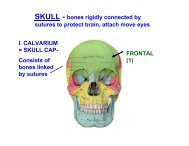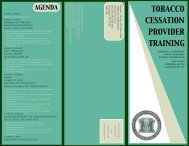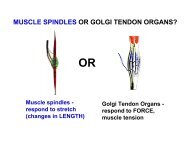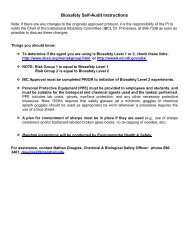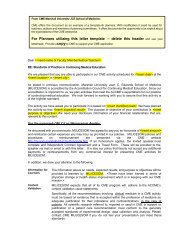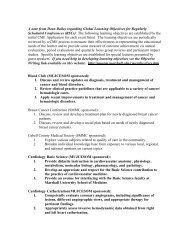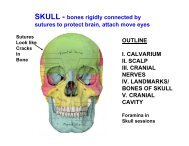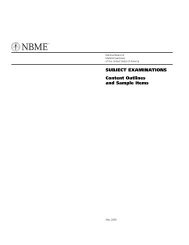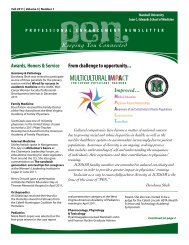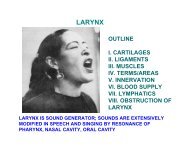FA 5 Progress Report WV-INBRE - Joan C. Edwards School of ...
FA 5 Progress Report WV-INBRE - Joan C. Edwards School of ...
FA 5 Progress Report WV-INBRE - Joan C. Edwards School of ...
- No tags were found...
Create successful ePaper yourself
Turn your PDF publications into a flip-book with our unique Google optimized e-Paper software.
Program Director/Principal Investigator (Last, First, Middle): Rankin, Gary O 60members exhibit elevated LDL cholesterol, triglycerides or both. With a prevalence <strong>of</strong> 0.5-2% in theUS population, FCH accounts for 10-20% <strong>of</strong> premature cardiovascular disease (CVD). FCH wasrecognized as a genetic disorder in the early 70s and was thought to be inherited as an autosomaldominant disorder. More recent studies including segregation analyses indicate a polygenic mode<strong>of</strong> inheritance. Several whole-genome scans and candidate gene studies from different populationshave identified a number <strong>of</strong> potential FCH susceptibility loci. We have compelling reasons forcontinuing our study <strong>of</strong> FCH families in the Appalachian population. (1) Based on previous linkageanalyses, there is evidence that more than one gene confers susceptibility to this disorder. (2)Since West Virginia has the 4nd highest rate <strong>of</strong> CVD in the US, determination <strong>of</strong> FCH susceptibilitygene(s) could help to understand the underlying pathology and ultimately reduce health disparitiesin this understudied population and shed light on the molecular basis <strong>of</strong> FCH heterogeneity. (3) Wehave identified families that are predicated on affected juvenile probands. Given that juvenile onset<strong>of</strong> dyslipidemia is now thought to predispose to cardiovascular disease, these families couldrepresent a novel form <strong>of</strong> FCH in which individuals are at increased risk for developing prematurecardiovascular disease.2. Background and Significance:Cardiovascular disease (CVD) is the leading cause <strong>of</strong> death in the US and Western societiescountries. According to the American Heart Association 2010 Statistical Update ~81.1 million USresidents have one or more types <strong>of</strong> CVD [1]. The state <strong>of</strong> <strong>WV</strong> incurs 309.2 CVD deaths per100,000 and has the 6th highest rate among the 50 states + DC and Puerto Rico. The overall USdeath rate is 262.5 per 100,000. The estimated total direct and indirect cost <strong>of</strong> CVD in 2010 is$503.2 billion [1]. Serum lipid levels such as LDL cholesterol, HDL cholesterol and triglycerides areknown CVD risk factors. Three inherited dyslipidemias [familial hypercholesterolemia (FH), FCHLand familial hypertriglyceridemia (FHTG)] contribute to the spectrum <strong>of</strong> CAD risk factors. FCHL isgenerally defined by elevation <strong>of</strong> LDL cholesterol and triglycerides and is one <strong>of</strong> the most commonfamilial dyslipidemias [2, 3, 4]. With a prevalence <strong>of</strong> 0.5-2% in the US population, FCHL accountsfor 10-20% <strong>of</strong> premature CVD [5]. FCHL was recognized as a genetic disorder in the early 70s andwas thought to be inherited as an autosomal dominant disorder [6, 7]. More recent studies includingsegregation analyses indicate a polygenic mode <strong>of</strong> inheritance [8, 9]. Several whole-genome scansand candidate gene studies from different population have identified a number <strong>of</strong> potentialsusceptibility loci.Most recent studies suggest that FCH is transmitted as either an oligogenic (caused by a smallnumber) or multifactorial (genes and environment) disease [8, 10, 11, 12, 13, 14]. FCH and FHTGare usually expressed in late adolescence [15, 16], but at least one study indicates when FCH ispresent in young children the penetrance <strong>of</strong> the disease is nearly 100% [15]. Seven genes havebeen shown to be associated with FCH but only three <strong>of</strong> these (Upstream Stimulating Factor(USF1) on 1q21, apolipoprotein A1/C3/A4/A5 cluster (designated apoA1 in this report) onchromosome 11 and LPL have been replicated [8, 17, 18]. USF1 is a basic helix loop helixtranscription factor that is a key regulator <strong>of</strong> numerous genes in lipid and glucose metabolism [18].USF1 SNP usf1s2 is significantly associated with FCH and is located within an evolutionarilyconserved 20 base pair region <strong>of</strong> intron 7. Electrophoresis mobility shift assays indicated that theregion bound specifically to nuclear proteins from HeLa extracts [19]. SNP rs3737787 (usf1s1) islocated in the untranslated region <strong>of</strong> exon 11 and captures most <strong>of</strong> the disease associated signal[8]. We also tested for linkage and association with coding SNP rs10825269 in the PCDH15 genewhich encodes a protocadherin recently showed to be associated with FCH and deafness [20].On chromosome 1q21 where USF1 is located, there is no evidence <strong>of</strong> genetic heterogeneity inFinnish families, whereas the proportion <strong>of</strong> Mexican, German and Chinese families contributing tolinkage ranged from 22% to 71% [reviewed in 8]. Pajukanta et al. [10] combined data fromgenome-wide screens performed in Finnish and Dutch populations. The pooled data analysisidentified 3 chromosomal regions, on 2p25.1, 9p23, and 16q24.1, where Logarithm <strong>of</strong> the Odds(LOD) scores were greater than 2.0. These observations taken together suggest that other geneticPHS 2590 (Rev. 06/09)Continuation Format Page



